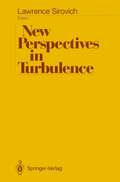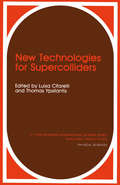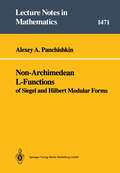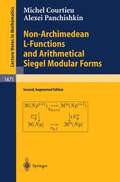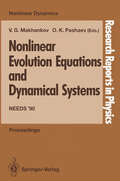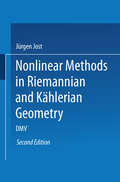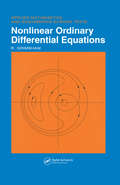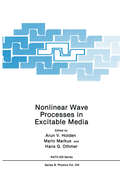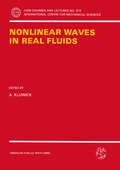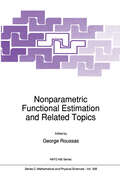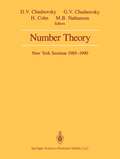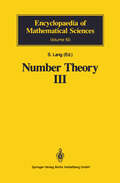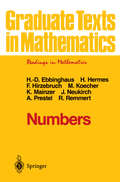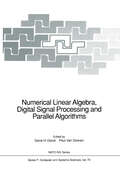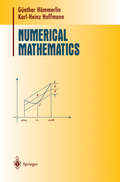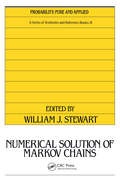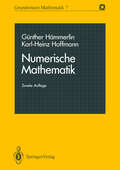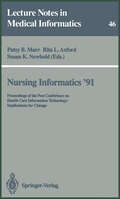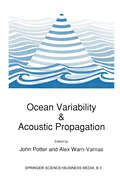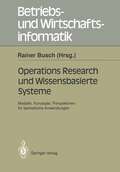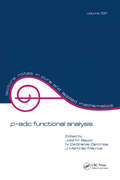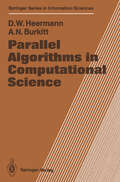- Table View
- List View
New Perspectives in Turbulence
by Lawrence SirovichThis collection of articles has its origin in a meeting which took place June 12-15, 1989, on the grounds of Salve Regina College in Newport, Rhode Island. The meeting was blessed by beautiful, balmy weather and an idyllic setting. The sessions themselves took place in Ochre Court, one of the elegant and stately old summer cottages for which Newport is acclaimed. Lectures were presented in the grand ballroom overlooking the famous Cliff Walk and Block Island Sound. Counter to general belief, the pleasant surroundings did not appear to encourage truancy or in any other way diminish the quality of the meeting. On the contrary, for the four days of the meeting there was a high level of excitement and optimism about the new perspectives in turbulence, a tone that carried over to lively dinner and evening discussions. The participants represented a broad range of backgrounds, extending from pure mathemat ics to experimental engineering. A dialogue began with the first speakers which cut across the boundaries and gave to the meeting a mood of unity which persisted.
New Technologies for Supercolliders (Ettore Majorana International Science Series #57)
by L. Cifarelli Thomas YpsilantisThe present volume is based on the proceedings of the 12th Workshop of the INFN ELOISATRON Project, held at the "Ettore Majorana" Centre for Scientific Culture (EMCSC), Erice (frapani), Sicily, Italy, in the period September 15-20, 1990. The proceedings deal with the presentation of "New Technologies for Supercolliders". Three new energy frontiers (16,40 and 200 TeV) are now opened up for the future of Subnuclear Physics. Basic problems above the Fermi-energy are crowding up: but no one knows the energy levels needed for their solution. This is why the technology for experiments with the new generation of Supercolliders needs to be pursued having in mind the problems which are of common interest in the three energy frontiers. The primary purpose of the Workshop was to contribute towards the highest energy limit in the search for new instruments and new technologies. Furthermore, the present status and performances of various detector technologies were reviewed. The possible options for a powerful apparatus whose goal would be the discovery of the top, Higgs and SUSY particles in a very high energy, high rate environment, were finally analysed. The Workshop was sponsored by the Italian National Institute for Nuclear Physics (INFN), the Italian Ministry of Education, the Italian Ministry of Scientific and Technological Research and the Sicilian Regional Government. We are thankful to the staff of EMCSC for their efficient and warm support.
Non-Archimedean L-Functions: of Siegel and Hilbert Modular Forms (Lecture Notes in Mathematics #1471)
by Alexei A. Panchishkin1) p n=1 The set of arguments s for which ((s) is defined can be extended to all s E C,s :f:. 1, and we may regard C as the group of all continuous quasicharacters C = Hom(R~, c>
Non-Archimedean L-Functions and Arithmetical Siegel Modular Forms (Lecture Notes in Mathematics #1471)
by Michel Courtieu Alexei A. PanchishkinThis book, now in its 2nd edition, is devoted to the arithmetical theory of Siegel modular forms and their L-functions. The central object are L-functions of classical Siegel modular forms whose special values are studied using the Rankin-Selberg method and the action of certain differential operators on modular forms which have nice arithmetical properties. A new method of p-adic interpolation of these critical values is presented. An important class of p-adic L-functions treated in the present book are p-adic L-functions of Siegel modular forms having logarithmic growth. The given construction of these p-adic L-functions uses precise algebraic properties of the arithmetical Shimura differential operator. The book will be very useful for postgraduate students and for non-experts looking for a quick approach to a rapidly developing domain of algebraic number theory. This new edition is substantially revised to account for the new explanations that have emerged in the past 10 years of the main formulas for special L-values in terms of arithmetical theory of nearly holomorphic modular forms.
Nonlinear Evolution Equations and Dynamical Systems: Needs ’90 (Research Reports in Physics)
by Vladimir G. Makhankov Oktay K. PashaevProceedings of the 6th International Workshop, 16-26 July 1990, Dubna, USSR
Nonlinear Methods in Riemannian and Kählerian Geometry: Delivered at the German Mathematical Society Seminar in Düsseldorf in June, 1986
by Jürgen JostIn this book, I present an expanded version of the contents of my lectures at a Seminar of the DMV (Deutsche Mathematiker Vereinigung) in Düsseldorf, June, 1986. The title "Nonlinear methods in complex geometry" already indicates a combination of techniques from nonlinear partial differential equations and geometric concepts. In older geometric investigations, usually the local aspects attracted more attention than the global ones as differential geometry in its foundations provides approximations of local phenomena through infinitesimal or differential constructions. Here, all equations are linear. If one wants to consider global aspects, however, usually the presence of curvature Ieads to a nonlinearity in the equations. The simplest case is the one of geodesics which are described by a system of second ordernonlinear ODE; their linearizations are the Jacobi fields. More recently, nonlinear PDE played a more and more pro~inent röle in geometry. Let us Iist some of the most important ones: - harmonic maps between Riemannian and Kählerian manifolds - minimal surfaces in Riemannian manifolds - Monge-Ampere equations on Kähler manifolds - Yang-Mills equations in vector bundles over manifolds. While the solution of these equations usually is nontrivial, it can Iead to very signifi cant results in geometry, as solutions provide maps, submanifolds, metrics, or connections which are distinguished by geometric properties in a given context. All these equations are elliptic, but often parabolic equations are used as an auxiliary tool to solve the elliptic ones.
Nonlinear Ordinary Differential Equations
by R. GrimshawOrdinary differential equations have long been an important area of study because of their wide application in physics, engineering, biology, chemistry, ecology, and economics. Based on a series of lectures given at the Universities of Melbourne and New South Wales in Australia, Nonlinear Ordinary Differential Equations takes the reader from basic elementary notions to the point where the exciting and fascinating developments in the theory of nonlinear differential equations can be understood and appreciated. Each chapter is self-contained, and includes a selection of problems together with some detailed workings within the main text. Nonlinear Ordinary Differential Equations helps develop an understanding of the subtle and sometimes unexpected properties of nonlinear systems and simultaneously introduces practical analytical techniques to analyze nonlinear phenomena. This excellent book gives a structured, systematic, and rigorous development of the basic theory from elementary concepts to a point where readers can utilize ideas in nonlinear differential equations.
Nonlinear Ordinary Differential Equations
by R. GrimshawOrdinary differential equations have long been an important area of study because of their wide application in physics, engineering, biology, chemistry, ecology, and economics. Based on a series of lectures given at the Universities of Melbourne and New South Wales in Australia, Nonlinear Ordinary Differential Equations takes the reader from basic elementary notions to the point where the exciting and fascinating developments in the theory of nonlinear differential equations can be understood and appreciated. Each chapter is self-contained, and includes a selection of problems together with some detailed workings within the main text. Nonlinear Ordinary Differential Equations helps develop an understanding of the subtle and sometimes unexpected properties of nonlinear systems and simultaneously introduces practical analytical techniques to analyze nonlinear phenomena. This excellent book gives a structured, systematic, and rigorous development of the basic theory from elementary concepts to a point where readers can utilize ideas in nonlinear differential equations.
Nonlinear Wave Processes in Excitable Media (Nato Science Series B: #244)
by Arunn V. Holden Mario Markus Hans G. OthmerProceedings of a NATO ARW held in Leeds, UK, September 11-15, 1989
Nonlinear Waves in Real Fluids (CISM International Centre for Mechanical Sciences #315)
by A. KluwickThe study of materials which exhibit new and unconventional properties is of central importance for the devel- opment of advanced and refined technologies in many fields of engineering science. In this connection there has been a rapidly growing interest in real fluid effects on wave phenomena in the past few years. A prominent example is provided by Bethe-Zel'dovich-Thompson (BZT) fluids which have the distinguishing feature that they exhibit negative nonlinearity over a finite range of temperature and pressures in the pure vapour phase. However, two phase flows with and without phase change are an even richer source of new unexpected and previously thought impossible phenomena. Topics covered by this volume include waves in gases near the critical point, waves in retrograde fluids, temperature waves in superfluid helium and density waves in suspensions of particles in liquids. Clearly, the aim of the various contributions is twofold. First, they are intended to provide scientists and engineers working in these and related areas with an overview of various new physical phenomena as for example expansion shocks, sonic shocks, shock splitting, evaporation and liquafaction shocks and the experimental techniques needed to study these phenomena. Second, an attempt is made to discuss aspects of their mathematical modeling with special emphasis on properties which these phenomena have in common.
Nonparametric Functional Estimation and Related Topics (Nato Science Series C: #335)
by G. G. RoussasAbout three years ago, an idea was discussed among some colleagues in the Division of Statistics at the University of California, Davis, as to the possibility of holding an international conference, focusing exclusively on nonparametric curve estimation. The fruition of this idea came about with the enthusiastic support of this project by Luc Devroye of McGill University, Canada, and Peter Robinson of the London School of Economics, UK. The response of colleagues, contacted to ascertain interest in participation in such a conference, was gratifying and made the effort involved worthwhile. Devroye and Robinson, together with this editor and George Metakides of the University of Patras, Greece and of the European Economic Communities, Brussels, formed the International Organizing Committee for a two week long Advanced Study Institute (ASI) sponsored by the Scientific Affairs Division of the North Atlantic Treaty Organization (NATO). The ASI was held on the Greek Island of Spetses between July 29 and August 10, 1990. Nonparametric functional estimation is a central topic in statistics, with applications in numerous substantive fields in mathematics, natural and social sciences, engineering and medicine. While there has been interest in nonparametric functional estimation for many years, this has grown of late, owing to increasing availability of large data sets and the ability to process them by means of improved computing facilities, along with the ability to display the results by means of sophisticated graphical procedures.
Number Theory: New York Seminar 1989–1990
by David V. Chudnovsky Gregory V. Chudnovsky Harvey Cohn Melvyn B. NathansonNew York Number Theory Seminar started its regular meeting in January, 1982. The Seminar has been meeting on a regular basis weekly during the academic year since then. The meeting place of the seminar is in midtown Manhattan at the Graduate School and University Center of the City Uni versity of New York. This central location allows number-theorists in the New York metropolitan area and vistors an easy access. Four volumes of the Seminar proceedings, containing expanded texts of Seminar's lectures had been published in the Springer's Lecture Notes in Mathematics series as volumes 1052 (1984), 1135 (1985), 1240 (1987), and 1383 (1989). Seminar co chairmen are pleased that some of the contributions to the Seminar opened new avenues of research in Number Theory and related areas. On a histori cal note, one of such contributions proved to be a contribution by P. Landweber. In addition to classical and modern Number Theory, this Semi nar encourages Computational Number Theory. This book presents a selection of invited lectures presented at the New York Number Theory Seminar during 1989-1990. These papers cover wide areas of Number Theory, particularly modular functions, Aigebraic and Diophantine Geometry, and Computational Number Theory. The review of C-L. Chai presents a broad view of the moduli of Abelian varieties based on recent work of the author and many other prominent experts. This provides the reader interested in Diophantine Analysis with access to state of the art research. The paper of D. V. and G. V.
Number Theory III: Diophantine Geometry (Encyclopaedia of Mathematical Sciences #60)
by Serge LangIn 1988 Shafarevich asked me to write a volume for the Encyclopaedia of Mathematical Sciences on Diophantine Geometry. I said yes, and here is the volume. By definition, diophantine problems concern the solutions of equations in integers, or rational numbers, or various generalizations, such as finitely generated rings over Z or finitely generated fields over Q. The word Geometry is tacked on to suggest geometric methods. This means that the present volume is not elementary. For a survey of some basic problems with a much more elementary approach, see [La 9Oc]. The field of diophantine geometry is now moving quite rapidly. Out standing conjectures ranging from decades back are being proved. I have tried to give the book some sort of coherence and permanence by em phasizing structural conjectures as much as results, so that one has a clear picture of the field. On the whole, I omit proofs, according to the boundary conditions of the encyclopedia. On some occasions I do give some ideas for the proofs when these are especially important. In any case, a lengthy bibliography refers to papers and books where proofs may be found. I have also followed Shafarevich's suggestion to give examples, and I have especially chosen these examples which show how some classical problems do or do not get solved by contemporary in sights. Fermat's last theorem occupies an intermediate position. Al though it is not proved, it is not an isolated problem any more.
Numbers (Graduate Texts in Mathematics #123)
by Heinz-Dieter Ebbinghaus Hans Hermes Friedrich Hirzebruch Max Koecher Klaus Mainzer Jürgen Neukirch Alexander Prestel Reinhold RemmertThis book is about all kinds of numbers, from rationals to octonians, reals to infinitesimals. It is a story about a major thread of mathematics over thousands of years, and it answers everything from why Hamilton was obsessed with quaternions to what the prospect was for quaternionic analysis in the 19th century. It glimpses the mystery surrounding imaginary numbers in the 17th century and views some major developments of the 20th century.
Numerical Linear Algebra, Digital Signal Processing and Parallel Algorithms (NATO ASI Subseries F: #70)
by Gene H. Golub Paul Van DoorenNumerical linear algebra, digital signal processing, and parallel algorithms are three disciplines with a great deal of activity in the last few years. The interaction between them has been growing to a level that merits an Advanced Study Institute dedicated to the three areas together. This volume gives an account of the main results in this interdisciplinary field. The following topics emerged as major themes of the meeting: - Singular value and eigenvalue decompositions, including applications, - Toeplitz matrices, including special algorithms and architectures, - Recursive least squares in linear algebra, digital signal processing and control, - Updating and downdating techniques in linear algebra and signal processing, - Stability and sensitivity analysis of special recursive least squares problems, - Special architectures for linear algebra and signal processing. This book contains tutorials on these topics given by leading scientists in each of the three areas. A consider- able number of new research results are presented in contributed papers. The tutorials and papers will be of value to anyone interested in the three disciplines.
Numerical Mathematics (Undergraduate Texts in Mathematics)
by Günther Hämmerlin Karl-Heinz Hoffmann"In truth, it is not knowledge, but learning, not possessing, but production, not being there, but travelling there, which provides the greatest pleasure. When I have completely understood something, then I turn away and move on into the dark; indeed, so curious is the insatiable man, that when he has completed one house, rather than living in it peacefully, he starts to build another. " Letter from C. F. Gauss to W. Bolyai on Sept. 2, 1808 This textbook adds a book devoted to applied mathematics to the series "Grundwissen Mathematik. " Our goals, like those of the other books in the series, are to explain connections and common viewpoints between various mathematical areas, to emphasize the motivation for studying certain prob lem areas, and to present the historical development of our subject. Our aim in this book is to discuss some of the central problems which arise in applications of mathematics, to develop constructive methods for the numerical solution of these problems, and to study the associated questions of accuracy. In doing so, we also present some theoretical results needed for our development, especially when they involve material which is beyond the scope of the usual beginning courses in calculus and linear algebra. This book is based on lectures given over many years at the Universities of Freiburg, Munich, Berlin and Augsburg.
Numerical Solution of Markov Chains
by William J. StewartPapers presented at a workshop held January 1990 (location unspecified) cover just about all aspects of solving Markov models numerically. There are papers on matrix generation techniques and generalized stochastic Petri nets; the computation of stationary distributions, including aggregation/disaggregation.
Numerical Solution of Markov Chains: Proceedings Of The 2nd International Workshop On The Numerical Solution Of Markov Chains
by William J. StewartPapers presented at a workshop held January 1990 (location unspecified) cover just about all aspects of solving Markov models numerically. There are papers on matrix generation techniques and generalized stochastic Petri nets; the computation of stationary distributions, including aggregation/disaggregation.
Numerische Mathematik (Grundwissen Mathematik #7)
by Günther Hämmerlin Karl-Heinz HoffmannDieser Band Numerische Mathematik hat Prinzipien des numerischen Rechnens, numerische lineare Algebra und Näherungsmethoden in der Analysis zum Inhalt. Der Begriff der Approximation zieht sich als roter Faden durch den gesamten Text. Die Betonung liegt dabei weniger auf der Bereitstellung möglichst vieler Algorithmen als vielmehr auf der Vermittlung mathematischer Überlegungen, die zur Konstruktion von Verfahren führen. Jedoch werden auch der algorithmische Aspekt und entsprechende Effizienzbetrachtungen gebührend berücksichtigt. An vielen Stellen geht der dargebotene Stoff über den Inhalt einer einschlägigen Vorlesung zur numerischen Mathematik hinaus, so daß man beim Gebrauch des Buches neben einer solchen Vorlesung eine Auswahl treffen wird. Dem Charakter der Reihe Grundwissen Mathematik entsprechend sind zahlreiche historische Anmerkungen eingeflochten. Besonderer Wert wird auf Querverbindungen und motivierende Erklärungen gelegt. Das Buch eignet sich zum Selbststudium und auch als Begleittext zu Vorlesungen. Diese 2. Auflage wurde überarbeitet und ergänzt. Zu den Ergänzungen gehört eine Darstellung der Idee der schnellen Fouriertransformation.
Nursing Informatics ’91: Proceedings of the Post Conference on Health Care Information Technology: Implications for Change (Lecture Notes in Medical Informatics #46)
by Susan K. Newbold Rita L. Axford Patsy B. MarrFor over a decade, Working Group 8 (Nursing) of the International Medical Informatics Association has sponsored, in conjunction with a host country, a triennial international symposium on nursing informatics. Each conference consists of a main conference and an invitational working conference following the main event. In 1991, the symposium was held in Melbourne, Australia and hosted by the Nursing Computer Group, Victoria and the Royal College of Nursing, Australia. Nine Pre-Conference workshops offered participants indepth exploration of a variety of information technology topics. The main conference attracted 700 participants from 19 countries and over 150 peer-reviewed papers. The invitational working conference was held at Whitehall in Sorrento, Victoria and involved the individual and collective work of 40 experts in nursing informatics from around the world. This group addressed the theme HEALTH CARE INFORMATION TECHNOLOGY: IMPLICATIONS FOR CHANGE. Health care organizations are faced with growing demand for information technology and must cope effectively with the processes and outcomes of its introduction. As the impact of information technology is felt both on the local and the global level, the conference selected for its theme a three tiered approach to information technology and organisational change - through the lens of society, the organization, and the individual. The conference was organized around three forms of contribution: plenary talks, working groups, and individual contributions by the participants. Part one of this book contains the papers of the plenary speakers for the conference.
Ocean Variability & Acoustic Propagation
by J. Potter A. Warn-VarnasFifteen years ago NATO organised a conference entitled 'Ocean Acoustic Modelling'. Many of its participants were again present at this variability workshop. One such participant. in concluding his 1975 paper, quoted the following from a 1972 literature survey: ' ... history presents a sad lack of communications between acousticians and oceanographers' Have we done any better in the last 15 years? We believe so, but only moderately. There is still a massive underdeveloped potential for acousticians and oceanographers to make significant progress together. Currently, the two camps talk together insufficiently even to avoid simple misun derstandings. such as those in Table 1. Table 1 Ocsanographic and acoustic jargon (from an idea by Pol/ardi Jargon Oceanographic use Acoustic use dbordB decibar (depth in m) decibel (energy level) PE primitive equations parabolic equations convergence zone converging currents converging rays (downwelling water) (high energy density) front thermohaline front wave, ray or time front speed water current speed sound propagation speed 1 The list goes on.
Operations Research und Wissenbasierte Systeme: Modelle, Konzepte, Perspektiven für betriebliche Anwendungen Ergebnisse der Arbeitsgruppe „Wirtschaftsinformatik“ der Deutschen Gesellschaft für Operations Research (DGOR) (Betriebs- und Wirtschaftsinformatik #49)
by Rainer BuschZiel der Deutschen Gesellschaft für Operations Research (DGOR) e.V. ist es, Operations Research (Unternehmensforschung) in Wirtschaft, Wissenschaft und in Verwaltung zu fördern und zu verbreiten. Dabei orientiert sie sich nicht nur an der im klassischen Sinne verstandenen Thematik, sondern befaßt sich auch mit den Themen, die im weiteren Sinne mit der Unter nehmensforschung verknüpft sind. Ausdruck dieser Orientierung sind zahl reiche Arbeitsgruppen mit entsprechender Themenstellung, so z.B. die Ar beitsgruppen "Personal Computing" und "Wirtschaftsinformatik". Mit den Arbeitsgruppen soll ein Forum angeboten werden, den Transfer von Wissen und Erfahrungen zwischen Theorie und Praxis zu fördern. Wirtschaftsinformatik als interdisziplinäres Fachgebiet zwischen Wirtschafts wissenschaften und Informatik (entsprechend der fortschreitenden Entwick lung der integrierten Fertigung (CIM) bestehen auch zunehmend interdiszi plinäre Überschneidungen mit den Ingenieurwissenschaften) befaßt sich mit dem Entwurf, der Entwicklung und dem Einsatz von Anwendungs- und Kommunikationssystemen in Wirtschaft und Verwaltung. Dabei sind die Prinzipien, Methoden, Modelle und Werkzeuge zu betrachten, die hierbei eingesetzt werden. Die Arbeitsgruppe "Wirtschaftsinformatik" nimmt hierzu aktuelle Themenstellungen auf, wobei sie -bedingt durch den heterogenen Teilnehmerkreis aus Banken, Handel, Industrie, Verwaltung und Wissen schaft - branchenspezifische Problemstellungen nur sekundär betrachtet. Theorie und Praxis sind in der thematischen Orientierung gleichgewichtig vertreten. Mit dem Rahmenthema "Operations Research und Wissensbasierte Systeme" sollte den Fragen nachgegangen werden, die sich aus den konkurrierenden Ansätzen der Modelle des Operations Research und Wissensbasierter Systeme ergeben, zumal festzustellen gilt, daß Wissensbasierte Systeme bzw. Experten systeme zunehmend für Anwendungsfelder entwickelt werden, zu denen bereits ausgereifte Operations-Research-Modelle mit effizienten Algorithmen existieren.
p-adic Function Analysis (Lecture Notes In Pure And Applied Mathematics Ser.)
by Jose M. Bayod"Written by accomplished and well-known researchers in the field, this unique volume discusses important research topics on p-adic functional analysis and closely related areas, provides an authoritative overview of the main investigative fronts where developments are expected in the future, and more. "
p-adic Function Analysis (Lecture Notes In Pure And Applied Mathematics Ser.)
by Jose M. Bayod"Written by accomplished and well-known researchers in the field, this unique volume discusses important research topics on p-adic functional analysis and closely related areas, provides an authoritative overview of the main investigative fronts where developments are expected in the future, and more. "
Parallel Algorithms in Computational Science (Springer Series in Information Sciences #24)
by Dieter W. Heermann Anthony N. BurkittOur aim in this book is to present and enlarge upon those aspects of parallel computing that are needed by practitioners of computational science. Today al most all classical sciences, such as mathematics, physics, chemistry and biology, employ numerical methods to help gain insight into nature. In addition to the traditional numerical methods, such as matrix inversions and the like, a whole new field of computational techniques has come to assume central importance, namely the numerical simulation methods. These methods are much less fully developed than those which are usually taught in a standard numerical math ematics course. However, they form a whole new set of tools for research in the physical sciences and are applicable to a very wide range of problems. At the same time there have been not only enormous strides forward in the speed and capability of computers but also dramatic new developments in computer architecture, and particularly in parallel computers. These improvements offer exciting prospects for computer studies of physical systems, and it is the new techniques and methods connected with such computer simulations that we seek to present in this book, particularly in the light of the possibilities opened up by parallel computers. It is clearly not possible at this early stage to write a definitive book on simulation methods and parallel computing.
